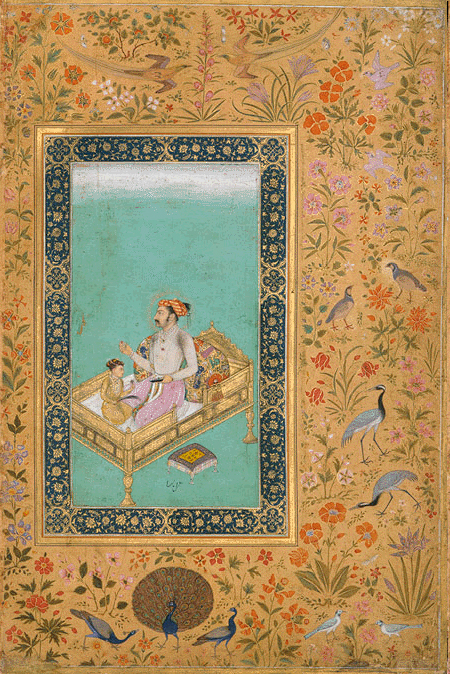
|
|
|
|
BY: SUN STAFF

Shah Jahan with Son Dara Shikoh Oct 08, 2010 — CANADA (SUN) — A serial presentation of the Mughal effect on Vaisnava society. Throughout this series on the Mughals in India, we have put some emphasis on the Mughal family lineage, and the fact that one after another, the fathers were deceived, cheated, imprisoned or killed by their sons. In the case of Shah Jahan's son, Dara (pictured above), he had been favored by his father to rule, but was quickly overcome by his more ambitious brothers.
In 1658 A.D. Shah Jahan took ill, and he chose his son Dara – eldest son of his beloved wife Mumtaz, to serve as the reigning Regent while he convalesced. This brought a swift reaction down on Dara's head, as his younger brothers marched their own armies to Agra, and quickly defeated Dara. One brother, Shuja, had been serving as the Viceroy of Bengal while another, Murad, was Viceroy of Gujarat. These two were joined by their most aggressive brother, Aurangzeb, who quickly claimed power when Dara was defeated. Although Emperor Shah Jahan recovered from his illness, Aurangzeb had him declared incompetent to rule, putting him under house arrest in Agra Fort until his death. Even while Shah Jahan lived freely, his sons wielded a great deal of power. Shuja, who served as governor in Bengal from 1639 to 1660, was kept busy handing out ancestral land grants to key persons in the region, and a great deal of wealth was moving from the hands of the Bengalis to the Mughals or their favored local Bengali representatives, who gave loyalty to the throne in return for local power. In The Rise of Islam and the Bengal Frontier, 1204–1760 by Richard M. Eaton (1993), we find a description of how such land deals played out through the medium of both government service and agricultural practice. As described in earlier segments, some of the emperors parlayed their relationships with sadhus and sannyasis in order to gain power through avenues of religious community. The local Hindu intelligentsia was also targeted, and awarded high paying jobs in the Mughal government in exchange for their loyalty. Local landowners, vaisya farmers, were also pulled onto the side of the Muslim rulers by land deals, as described by Eaton: The Mughal State and the Agrarian Order in Bengal "From the reign of Akbar onward, the Mughals sought to integrate Indians into their political system at two levels. At the elite level they endeavored to absorb both Muslim and non-Muslim chieftains into the imperial service, thereby transforming potential state enemies into loyal servants. They also sought to expand the empire's agrarian base, and hence its wealth, by transforming forest lands into arable fields and the semi-nomadic forest-dwelling peoples inhabiting those lands into settled farmers. "From the time of Shah Jahan [1627–58]," records an eighteenth-century revenue document, it was customary that wood-cutters and plough-men used to accompany his troops, so that forests may be cleared and land cultivated.…Ploughs used to be donated by the government. Short-term pattas [documents stating revenue demand] were given, [and these] fixed government demand at the rate of 1 anna per bigha during the first year. Chaudhuris [intermediaries] were appointed to keep the ri‘aya [peasants] happy with their considerate behaviour and to populate the country. They were to ensure that the pattas were issued in accordance with Imperial orders and the pledged word was kept. There was a general order that whosoever cleared a forest and brought land under cultivation, such land would be his zamindari. Ploughs should also be given on behalf of the State. The price of these ploughs should be realised from the zamindars in two to three years. Each hal mir (i.e., one who has four or five ploughs) should be found out and given a dastar [sash or turban; i.e., mark of honor] so that he may clear the forests and bring land into cultivation. In the manner, the people and the ri‘aya would be attracted by good treatment to come from other regions and subas [provinces] to bring under cultivation wasteland and land under forests. [1] An undated order by Shah Jahan's successor, Aurangzeb (1658–1707), reveals a similar concern with increasing arable acreage, adding that should any peasant flee the land, the local revenue officers ( ‘amil) "should ascertain the cause and work very hard to induce him to return to his former place." [2] Such an appeal hardly suggests a state bargaining from a position of strength. In fact, it points to the chronic surplus of land over labor that obtained in premodern India generally, and in Bengal until as late as the mid nineteenth century." During the time of Sri Caitanya Mahaprabhu, many of the zamindars in Bengal who are mentioned in sastric pastimes came into power in much the same way as described above. Just as the British did later on, the Mughals were compelled to actively motivate and organize the local Bengalis, so that adequate foodstuffs and profits would be produced for them. While the native Bengalis, most of whom were Vaisnavas, depended on Sri Krsna or Vishnu for their daily upkeep, the Mughal empire operated on a far more mundane system. Having experienced severe drought and famine in India on several occasions, they were determined to maintain an agricultural system that would ensure their own wellbeing. When doing so required placating or enthusing the local citizens, the Mughals would even help build Vaisnava temples for them. But when motivation by fear was preferred, they would just as happily tear all those temples down.
| |